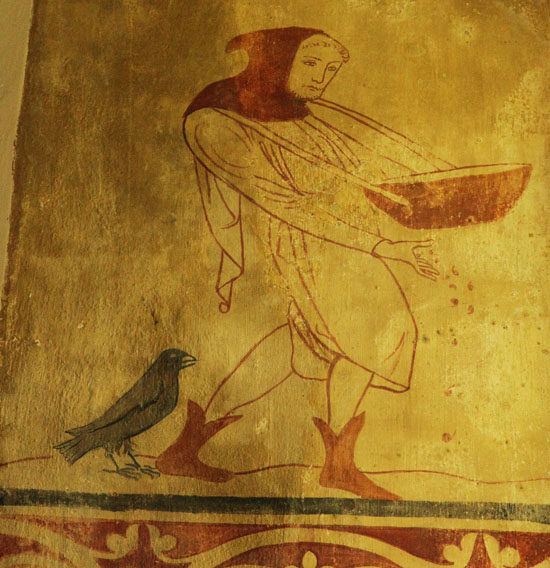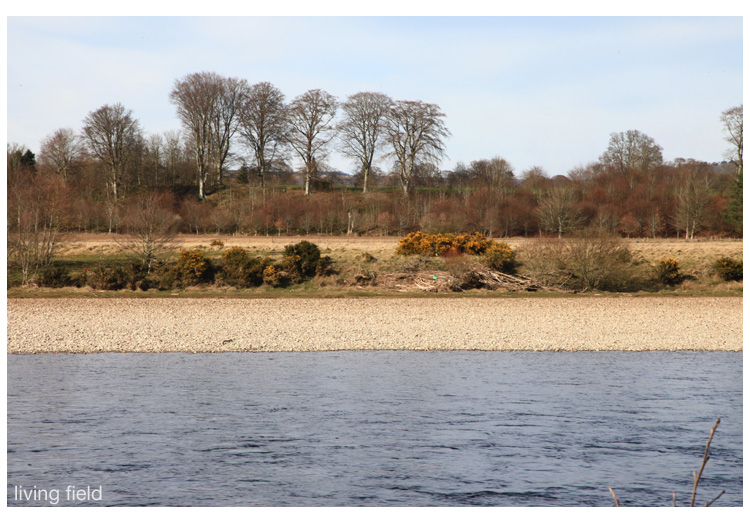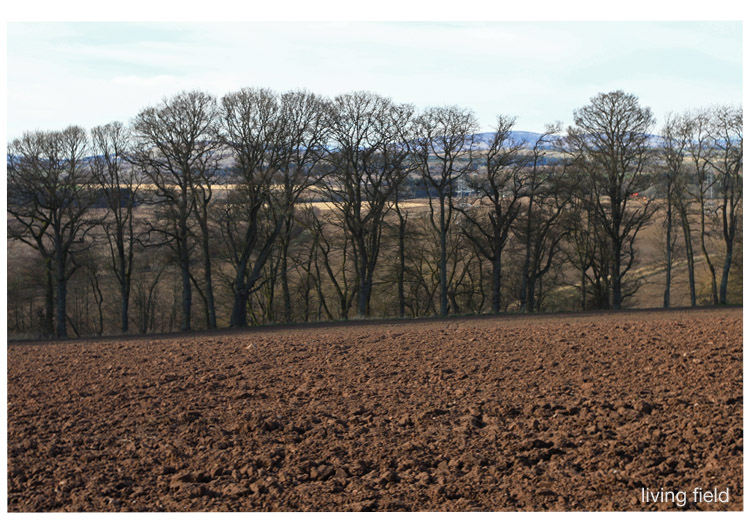A summary of various articles on bere and other barleys from the Living Field project. First records of barley in the late stone age (neolithic). Structure – six-rowed, two-rowed (and four-rowed?). Origins of bere uncertain. Its name – from bere to bigg. Bere not exclusively Scottish – similar forms reported from mainland Europe in the early 1800s. Geographical distribution mostly to the north in the 1850s. Bere’s decline in the 1900s.
Bere – an ancient grain
Bere is one of a group of cereal or corn crops grown at the Living Field garden near Dundee [1]. It is a landrace of the barley group. As a landrace [2], it is maintained from year to year from saved seed – and has been for centuries in Scotland. Each year, plants suited to the climate will leave more seed than others less suited, so gradually the characteristics of the population may shift. The bere grown in a particular region may become adapted to the climate and soils of that region.
The Living Field got its bere seed from Orkney – from the Agronomy Unit at Orkney Collage and from Barony Mills – and though very little bere is now grown outside a few fields in Orkney, collections held at the James Hutton Institute include bere and other landraces from several northern locations. Bere is quite distinct from other old barley varieties such as Spratt and Old Cromarty.

Barley originated to the east of the Mediterranean Sea. Seed was gradually brought across Europe until it eventually reached Britain 5000-6000 years ago [3]. Barley ears with grains are first recorded at neolithic or late stone age settlements, and repeatedly through Bronze and Iron ages and onwards [3]. They are best preserved where the ears holding the grain had been charred in a fire.
Bere and similar types of barley therefore have a long history in these Islands. Yet it is unclear whether those grown by neolithic settlers started a line that led directly to the bere recorded in the 1800s and that present today. There was repeated migration of people from Europe from the earliest times, and it is not hard to imagine that seed would have been brought across the sea on many occasions.
Bere and other barleys have been one of the main staple grains of the region, along with oat and pea [4]. These ancient grains have sustained people for thousands of years, even up to the early 1900s. Today, bere is a heritage crop, but now getting needed recognition as a source of breeding material and a nutritious food.
The rest of this article presents some of the history of bere, including its fate after the 1700s, its relation to barley and the degree to which these two crops have been considered different.

Structure – six-row, two row, four-row, naked and clothed?
To appreciate the various records from pre-history to the present, it is necessary to know a little of the structure of the barley ‘ear’ that holds the grains. Cultivated barley is defined by the row-structure in the ‘ear’. Grain sites are formed in triplets, on both sides of the ear’s rachis, a kind of stem. There are types in which all grains in the triplets fill. As the two set of triplets fill along the length of the ear, they form six vertical rows and are named six-rowed. There are also types where only two of the six fill, and these are named two-rowed. The unfilled grain sites appear as little ‘pegs’. The difference is clear when 2-rowed and six-rowed are shown side by side as in the photographs below.
Bere is generally included within the six-row group, because all six grains form and fill, but bere types have also been named 4-rowed, for example by the Lawsons, Edinburgh seed merchants, working in the 1800s [5], and also in a modern definitive UK flora [6]. In the four-rowed class, six grains form, but the outer two (the lateral ones) on opposite sides of the rachis merge into one row, so there are two rows of central grains and what appear to be just two rows of the four outer grains. The structure of bere can change on the same ear, leading to the Lawsons naming bere six- and four-rowed barley [5, see also 6].

The distinction is also made between naked barley in which the grains do not adhere tightly to the surrounding protective tissue, and hulled barley, in which the protective layers remain and are difficult to separate off.
The barley that has been found at prehistoric sites is six-rowed and variously naked or hulled. Bere today is mostly classed as a hulled barley, but as recently as the 1800s naked 4-rowed were still cultivated [5].
Bere in the historical records – is it uniquely Scottish?
The word bere and its variations have been in use for at least 9 centuries. Macleod [7] writes that in the Dictionary of the Older Scottish Tongue (DOST), covering usage from the 12th century to 1700, bere occurs also as bear, bair and beir. The other name by which it is known, big or bigg (from Old Norse Bygg) “does not seem to be in the DOST record” which implies it was pre-dated by bere and not recorded in use before 1700. It is also unclear whether bere and barley mean the same or different things in these early writings. Macleod cites the use of ‘barley beir’ for example.
Bere and barley were both in common usage in records of the agricultural improvements after 1700, for example in Andrew Wight’s account of travels around Scotland, 1778 – 1784 [8] and in the Old Statistical Account, 1791-1799 [9]. Sometimes both names are used when referring to crops at the same location, implying they were regarded as different crops, but at other times the distinction is unclear.

By the early 1800s, the published information on crops had been greatly expanded, especially through the various descriptive lists prepared by the Lawsons’ seed company in Edinburgh, notably in 1836 and 1852 [5]. Most of the barley varieties were named under two groups. One they define as Four-rowed, of which there were 12 types, some local and some from overseas including those named African, Bengal, Himalayan and Peruvian. The second group, recorded as a different species [10] was Two-rowed or Long-eared barley of which there were 26 types, again some sourced overseas. They also distinguished what they called true six-rowed, comprising one or possibly two types and an unusual form named Spratt (which is shown among the images on this page).
Common Bere was among the four-rowed and was also named Barley, Bigg or Rough Barley. So the Lawsons are implying that bere was also referred to as barley among farmers and merchants. It seems that around that time, the term ‘barley’ referred to two-rowed types, but could also be used for the four-rowed, and was therefore a general name for all cultivated barleys, whereas ‘bere’ referred to the local representative of the four(six-)-rowed types.

One of the most interesting pieces of information in the Lawsons’ account shows that Scotland’s ‘common bere’ was by no means unique. One other type, named Victoria bere, was stated as being received from the Belfast Botanic Gardens in 1836 and undergoing improvement by field trialling and selection. Another type, named Square, was received by the Lawsons from M. Vilmorin and Co., Paris, and had the following character: “Differs from the Common Bere in being three or four days sooner ripe, and having a thinner skin; properties which it may have acquired by being grown successively in the more genial climate of France, and is probably the same variety.” It is likely but not certain that Square was grown in France but the authors report ‘it was cultivated extensively in some parts of Germany’.
So even as recently as the mid-1800s, bere was not seen to be a uniquely Scottish form of barley. Something very like it was grown elsewhere in Europe. Also, they include in the four-rowed group, two naked types – the Naked or Siberian (“Ear similar in shape to the Common Bere, but rather more distinctly six-rowed … “) and an earlier form named Old Scottish Four-Rowed Naked, neither of which were much grown at that time.
In the Lawsons’ account therefore, naked and hulled forms of 6- or 4- rowed barleys were still grown in the mid-1800s, as they were in the neolithic.
Occurrence in the 1850 agricultural census and later
The area and yield of crops in Scotland were first recorded in a major agricultural census in the 1850s. The statist Thomas Thorburn presented averages of sown area and yield for each of the Old Counties and they have been were arranged by the Living Field on a map of Scotland [11].
The circles on the maps below represent the area of crops placed at the centres on the old counties. For reference, the internal boundaries show current administrative areas. Bere is shown on the left and barley on the right. Over the whole country, barley occupied about 10 times more area than bere, but at that time even barley covered a much smaller area than the main corn crop, oat. Bere, though present in most counties, was mainly grown in the north.

Distribution of bere (left) and barley (right) from the 1854 census. Each circle represents the area of crop in one of the pre-1890s counties. For a circle of given size, crop areas are 10 times greater for barley. Orkney and Shetland formed one area in the census: bere represented by the large circle just above Orkney; the arrow on the right pointing to the small area grown with barley. Full description at Thorburn’s Diagrams [11].
The 1850s census recorded yield in bushels, a measure of dry volume. A bushel does not necessarily measure the same weight in different grain lots since it varies with the density of the grain and the amount of chaff [11]. Converting census records from bushels and using the same conversion for both bere and barley indicates that bere yield was 80-90% of barley yield over Scotland as a whole but similar in northern counties at 1.5 to 2.0 t/ha. (Modern barley yields are typically 5 to 6 t/ha.)
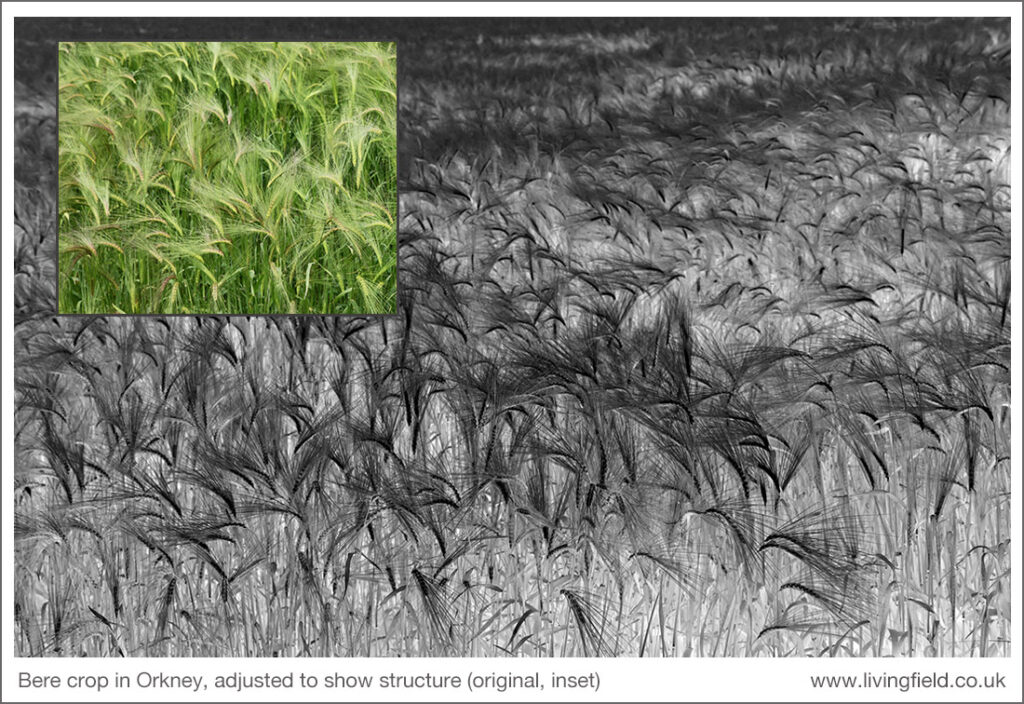
Decline
The agricultural census continued in the 1880s, after a break. By 1912, bere occupied 5.4% of the total barley, so quite a bit down as a proportion of the total from the 1850s. The total barley itself was only 20% of the area sown with oats.
During the 1920s, 1930s and up to 1944, bere was still mentioned in the census, its area was not given separately but included with barley. In the 1950s bere was no longer mentioned – barley area alone was given alongside oats, wheat and rye.
[To be updated as further information on bere becomes available.]
Sources / references
[1] For a general introduction to the Living Field’s work on cereal landraces – Ancient grains at the Living Field – 10 years on.
[2] Landraces: articles on this web site – What are landraces? and Landrace -1 bere, and then The bere line – rhymes with hairline.
[3] Dickson C, Dickson JH. 2000. Plants and people in ancient Scotland. Tempus Publishing, UK.
[4] The Living Field article on Peasemeal, Beremeal, 0atmeal gives a recent historical account of these three grains. Cooking tips from the Living Field’s correspondents can be found at The bereline – rhymes with hairline.
[5] The Living Field article Bere in Lawson’s Synopsis summarises work by the Lawsons, seed merchants working from Edinburgh in the 1800s. Their main works are: (1) Peter Lawson and Son 1836. The Agriculturist’s Manual. Edinburgh, London and Dublin, (2) Lawson and Son. 1852. Synopsis of the vegetable products of Scotland. Edinburgh: Private Press of Peter Lawson and Son. Copies are available online via the Biodiversity Library and Google Books.
- Of the four-rowed types they write – “middle grains on each side forming a distinct straight row; lateral ones forming a kind of double row towards the base, but uniting so as to form one row towards the extremity of the spike; so that instead of being named four or six-rowed, they might with more propriety be named four and six-rowed barleys.”
- On the definition of naked: “The difference in naked and other barleys, consists in the palea, or husk, separating from the grain in thrashing, as in common wheats.”
[6] Stace C. 1991. New Flora of the British Isles (second edition 1997). Cambridge University Press. The following appears: “Usually the three fertile florets per triplet produce 6 vertical rows of caryopses in the spike, but in some cultivars the 2 lateral rows of triplets on opposite sides of the rachis are superimposed producing four vertical rows (Four-rowed barley)”.
[7] The Living Field article Bere, Bear, Bair, Beir, Bygg summarises the use and origin of words for bere as related in – Macleod, I. 2005. Cereal terms in the DOST record. In: Perspectives on the Older Scottish Tongue. Eds Kay CJ, Mackay MA, pp 73-83, Edinburgh University Press. Reproduced online in the Scottish Corpus of Text and Speech Document 840.
[8] Wight, A. 1778-1784. Present State of Husbandry in Scotland. Extracted from Reports made to the Commissioners of the Annexed Estates, and published by their authority. Edinburgh: William Creesh. Vol I, Vol II, Vol III Part I, Vol III Part II, Vol IV part II, Volume IV Part II. All available online via Google Books. For more at the Living Field on Wight’s observations – Great quantities of Aquavitae, Great quantities of Aquavitae II and The Mill at Atholl.
[9] The Old Statistical Account 1791-1799.
[10] The taxonomic naming of barley in not consistent. The Lawsons named four-rowed as Hordeum vulgare and the two-rowed as Hordeum distichon, as does Stace [6] who commented that they were ‘better amalgamated’. Most authorities today [e.g. 13] group them as one species, Hordeum vulgare, and distinguish the forms as sub-species.
[11] The Living Field article Thorburn’s Diagrams gives a summary of the 1850s crop census: Thorburn T. 1855. Diagrams, Agricultural Statistics of Scotland for 1854. London: Effingham Wilson. The Living Field article Bere Country gives maps of bere and barley in the 1850s based on Thorburn’s county averages. For more explanation of bushels and other measures of dry volume: Light on bushel and Grain measures in Ancient Greece.
[12] Agricultural Statistics provided by Scottish Government can be accessed at Scottish Agriculture: Economic Reports.
[13] Wallace, M., Bonhomme, V., Russell, J. et al. Searching for the Origins of Bere Barley: a Geometric Morphometric Approach to Cereal Landrace Recognition in Archaeology. J Archaeol Method Theory 26, 1125–1142 (2019). https://doi.org/10.1007/s10816-018-9402-2
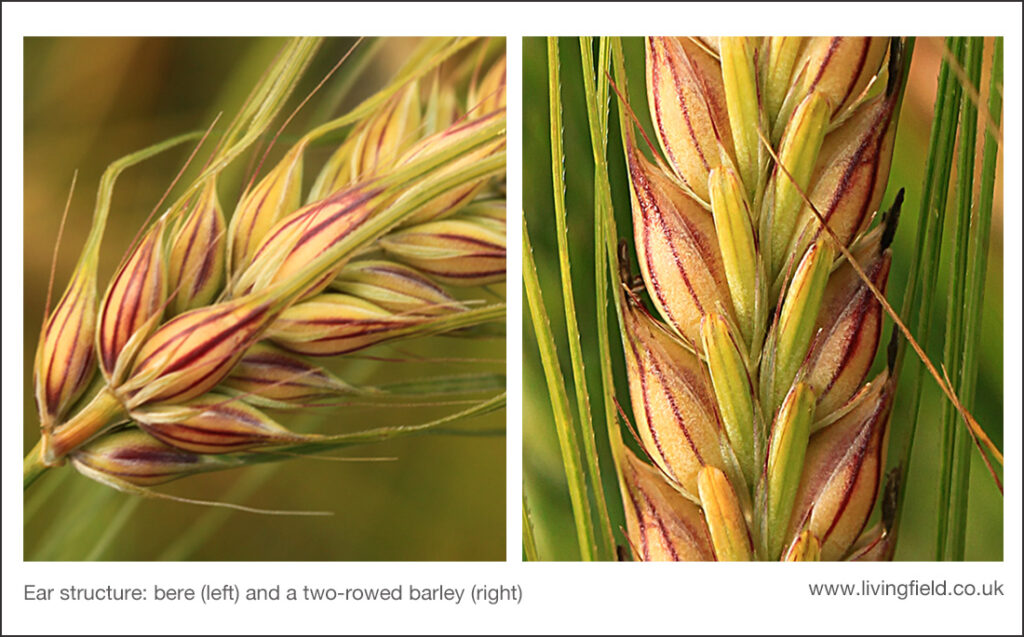
Contacts
All the bere and barley – except those photographed in Orkney fields – were grown at the Living Field garden at the James Hutton Institute near Dundee by Gladys Wright and Jackie Thompson. Geoff Squire assembled the text above.
Photographs by squire for the Living Field www.livingfield.co.uk and curvedflatlands www.curvedflatlands.co.uk web sites.
Author / contact: geoff.squire@hutton.ac.uk and geoff.squire@outlook.com.
[Update – minor edits, 12 June 2022]

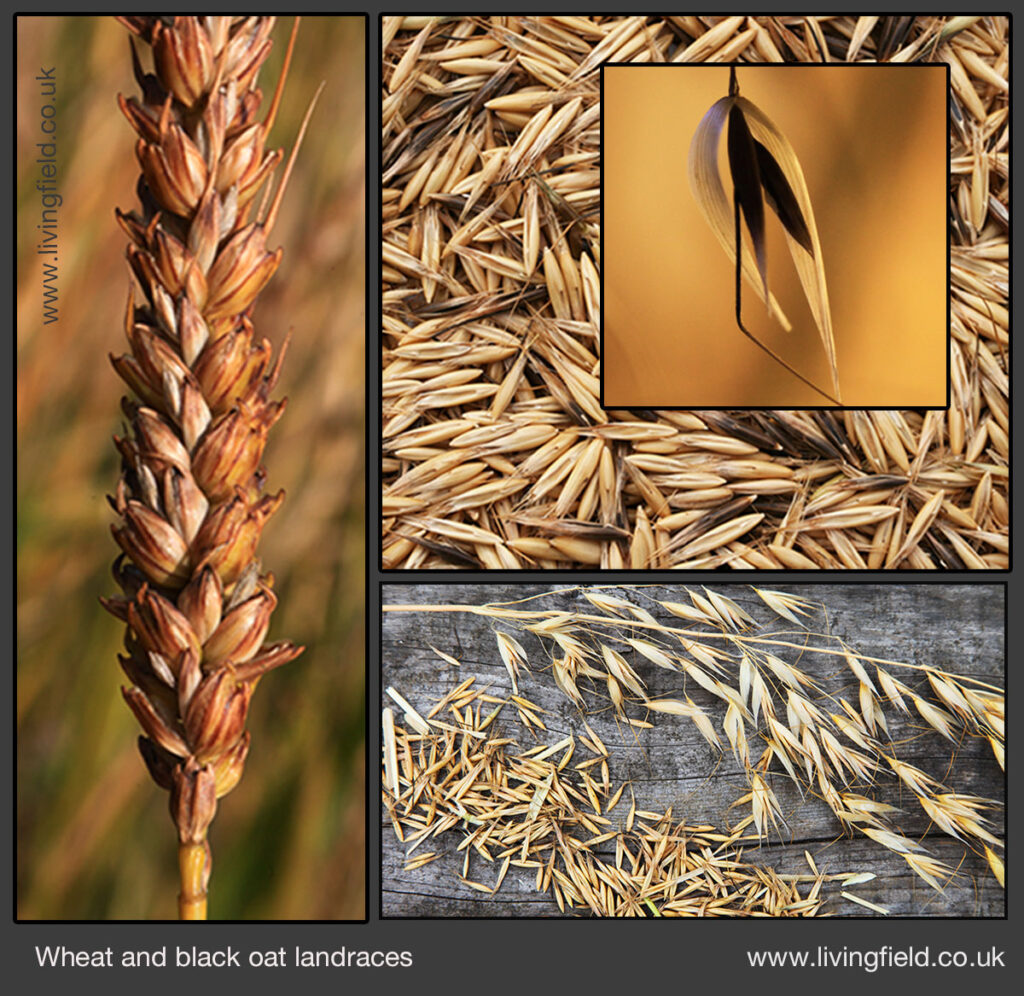






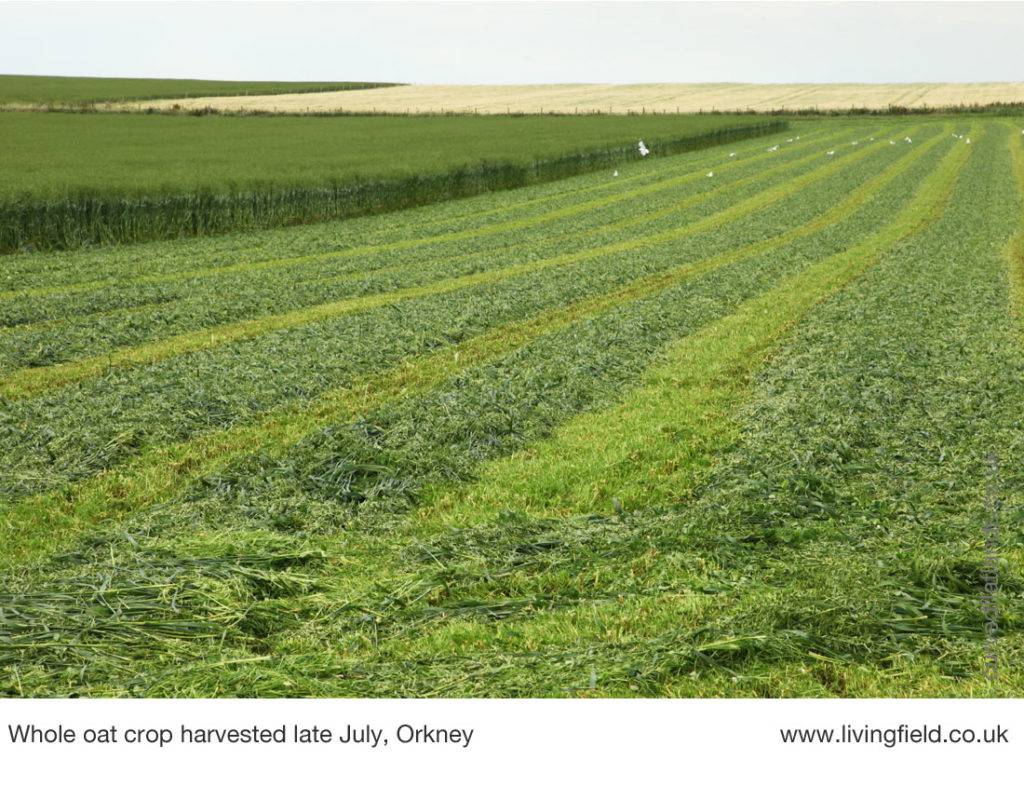

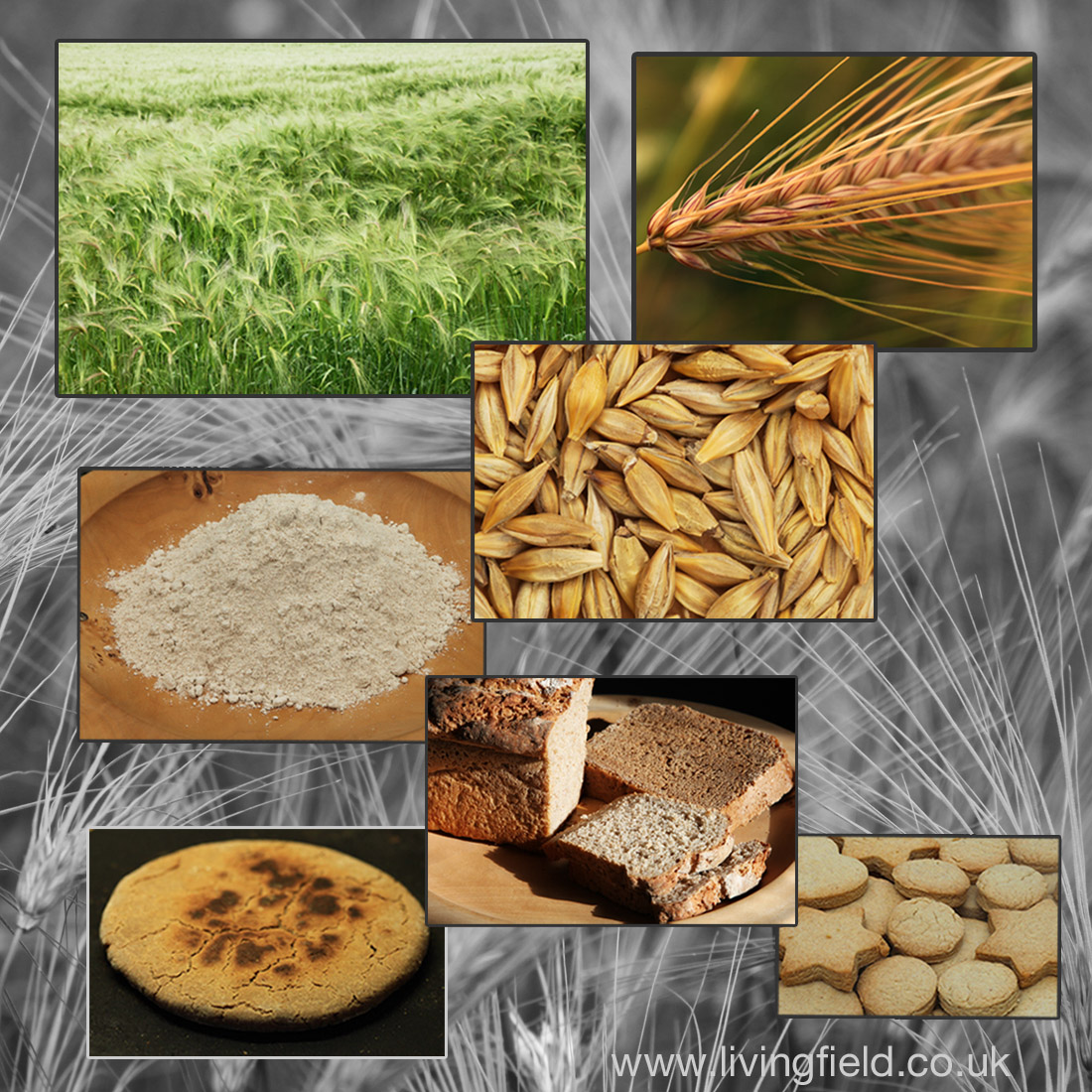









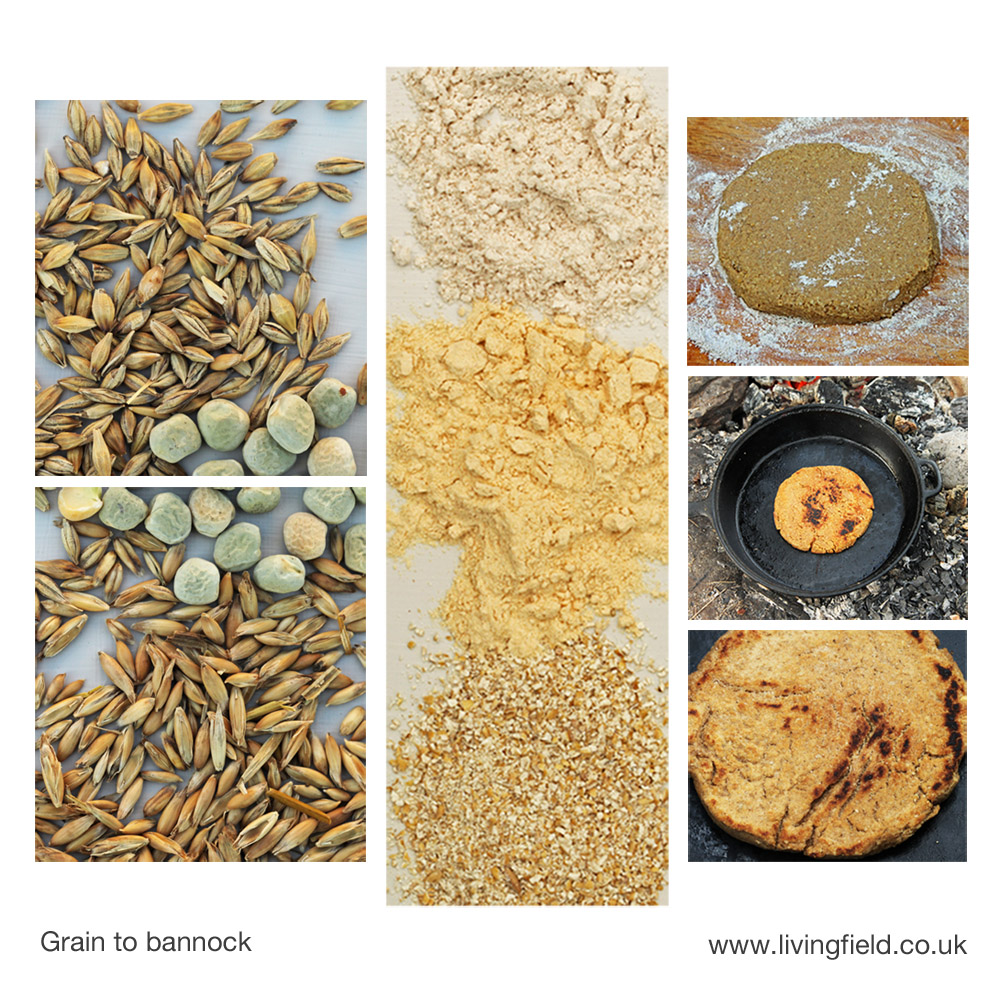

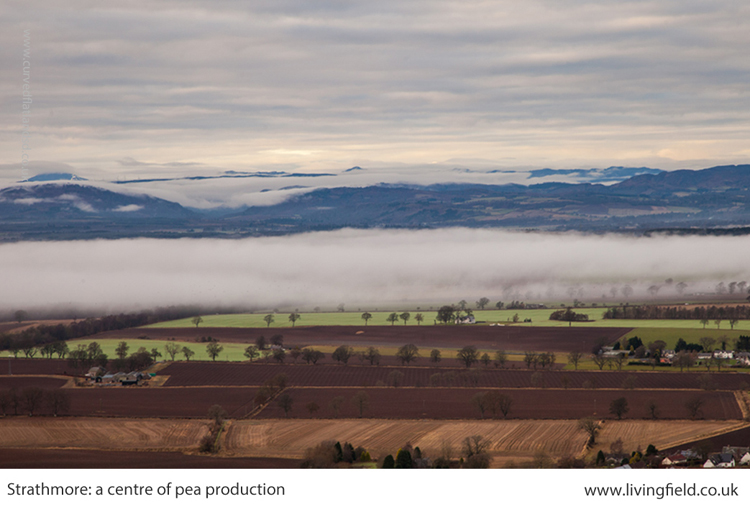
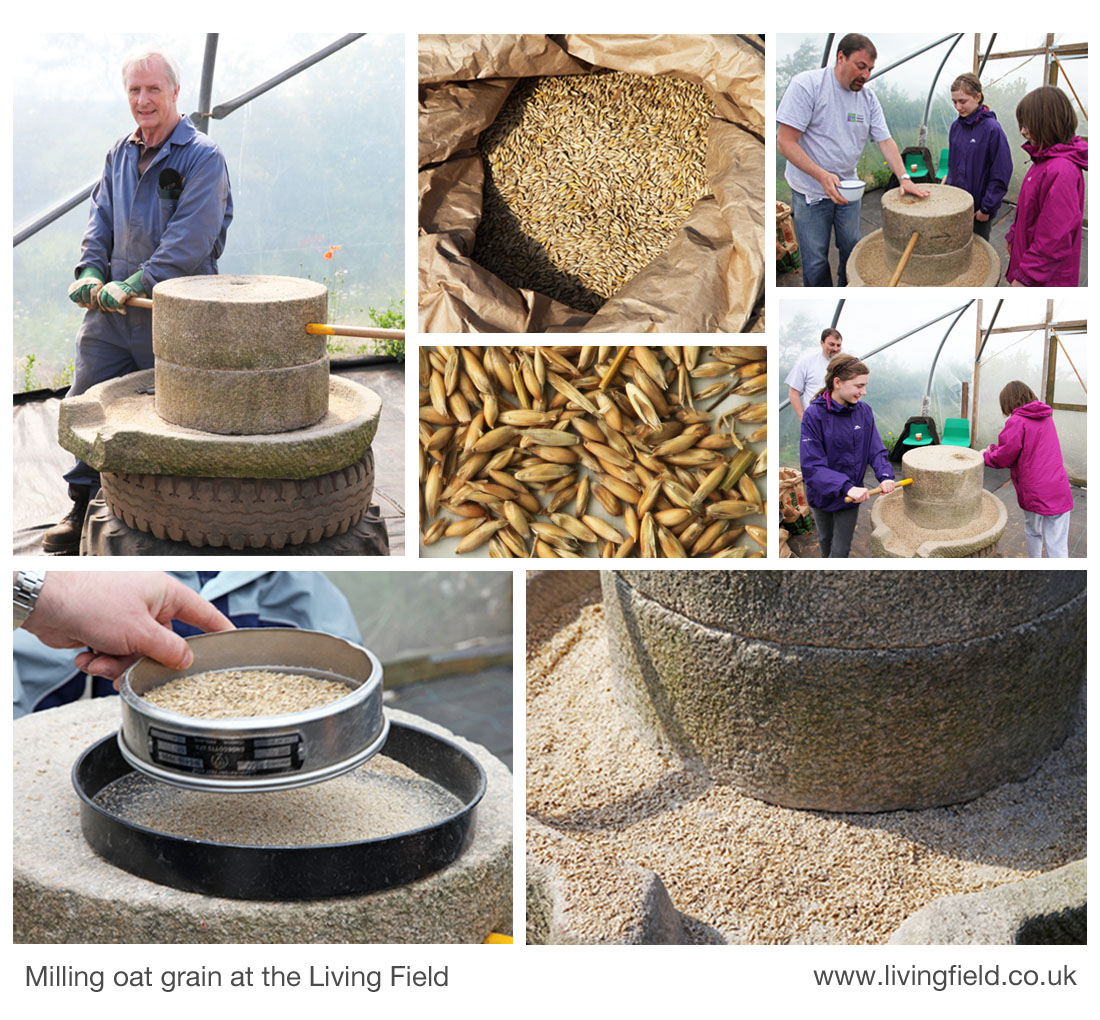


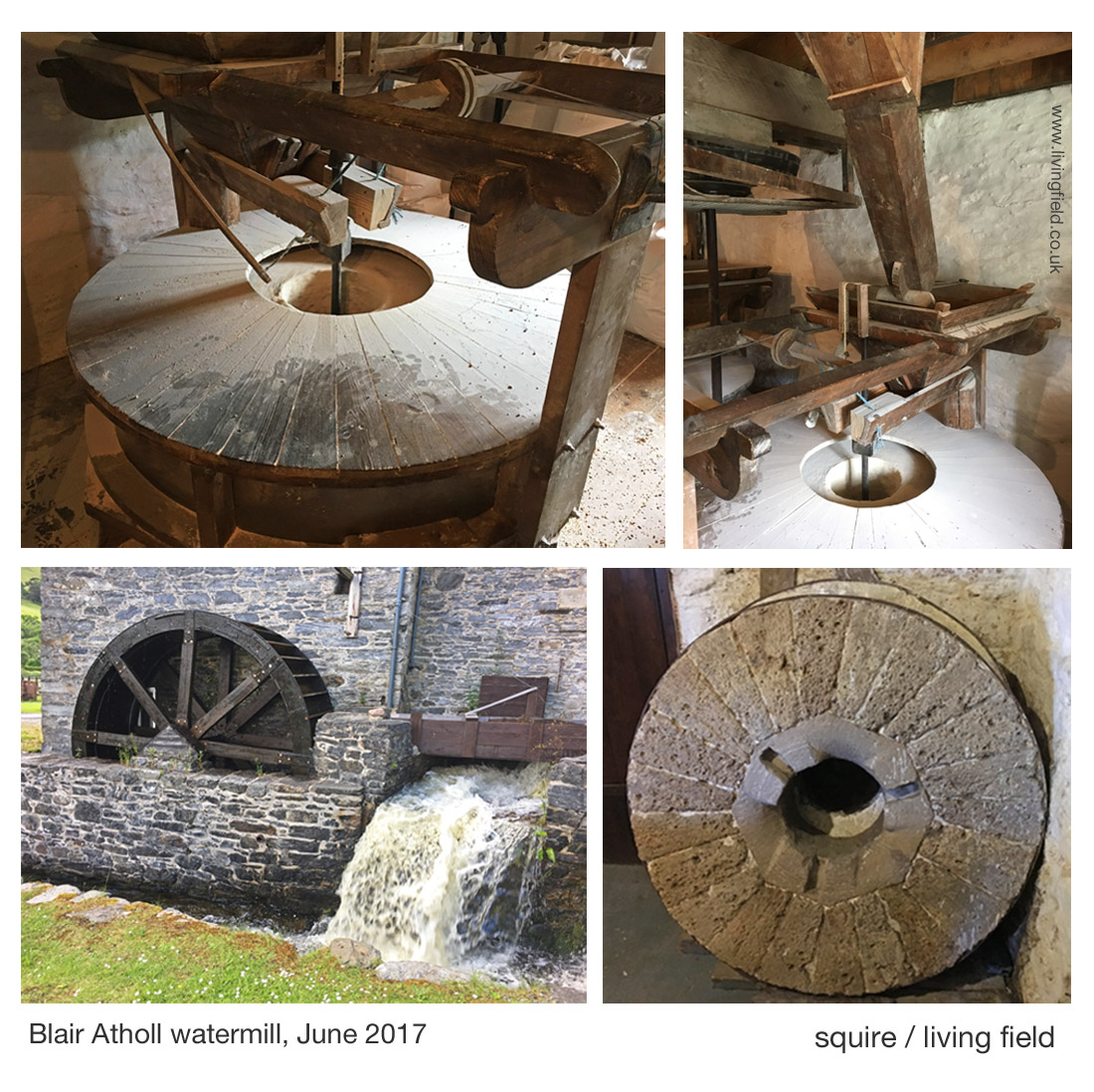 The images above show the water wheel fed by a lode that runs from the river Tilt to the north, the main grinding wheel (covered, top l), hoppers feeding the wheel and an old mill wheel. The watermill’s web site [1] and the explanation boards in the mill itself describe the history of the building and workings of the machinery.
The images above show the water wheel fed by a lode that runs from the river Tilt to the north, the main grinding wheel (covered, top l), hoppers feeding the wheel and an old mill wheel. The watermill’s web site [1] and the explanation boards in the mill itself describe the history of the building and workings of the machinery.

